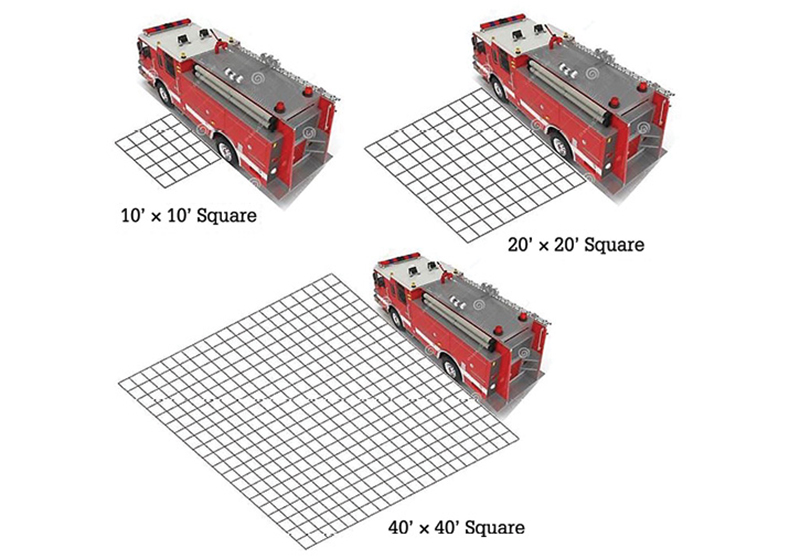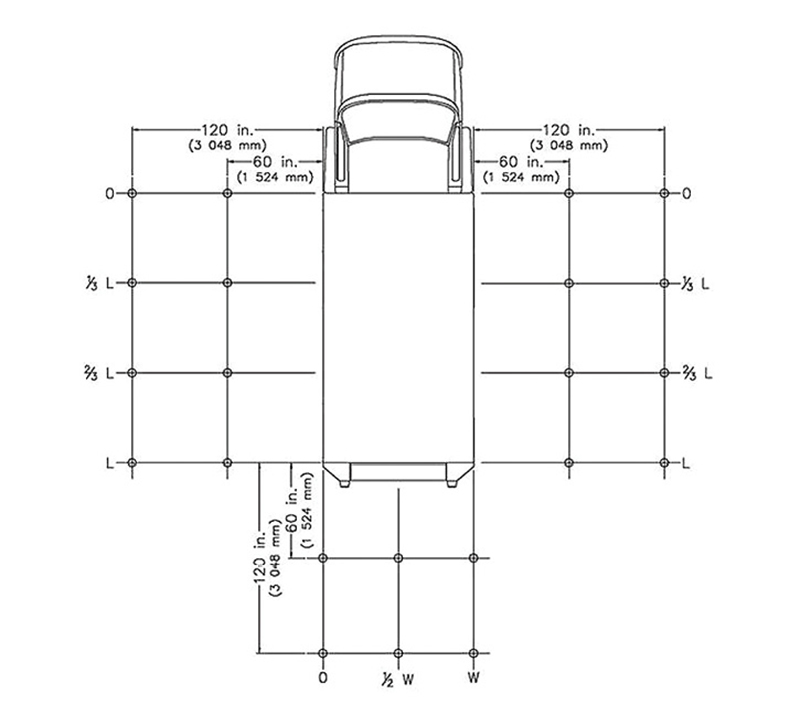3 Things to Consider When Purchasing a Ground Illumination Light
This article was first published in the November 2022 edition of Fire Apparatus & Emergency Equipment.
By Jim Stopa
In my article “Debunking Myths About Lumens” (October 2022), I made some bold statements about how the number of lumens doesn’t impact how effective a scene light will be at ground illumination.
In this article, I’ll talk about what you should look for in effective scene lighting. Determining the differences between scene lights and deciding which one is right for your application can be simplified by looking at three factors: Zone Total, Effective Ground Coverage, and Uniformity Ratio.
ZONE TOTAL
Zone Total is an important consideration because it tells the light’s effective usable brightness. To determine Zone Total, you must first identify the ground illumination area, or the square footage on the ground that needs to be illuminated, and then measure the light’s foot candles (fc). The current standards, National Fire Protection Association (NFPA) 1901/1906 and AMD-024, use a 10-foot by 10-foot area, divided up into multiple squares, with the center of each square being the target to measure illumination in fc. There are discussions among some in the industry to expand these standards to include a 20-foot by 20-foot area or even a 40-foot by 40-foot area divided into 2.5-foot squares. The thinking is that these larger areas would more accurately resemble what is typically used around apparatus at an emergency scene (Figure 1). While the Ambulance Manufacturers Division (AMD) test method is an ambulance document not applicable to fire apparatus, I believe it is relevant to this article.

Once you’ve identified the area, the most common way to figure out a light’s fc is to measure it with a Foot Candle/Lux Meter. First, the light is set up outside at night, in a dark area, and the ground area squares are constructed as shown in Figure 1. Then the meter is positioned in the center of each square and records the value in fc. When the fc values of all the squares in the area have been measured, the maximum and minimum values are noted. The current NFPA and AMD standards don’t include maximum fc values for scene lights but do set minimums of 3 fc and 1 fc, respectively.
Adding up the fc values of all the squares in the ground area gives you the light’s Zone Total. The larger the number, the brighter the light. Zone Total is especially important because it only measures the light being used and not the wasted light that is projected into the sky.
EFFECTIVE GROUND COVERAGE
The next factor to consider when choosing the right scene light for your needs is Effective Ground Coverage, which is displayed as a percentage and is included in NFPA and AMD standards. It is calculated by dividing the number of squares that have values above the light’s minimum fc by the total number of squares. It’s interesting to note that the standards do differ on this percentage. You only need light to the rear of the apparatus with a value of 80% to follow the NFPA standard, while AMD requires lights to the sides and rear of the ambulance and 100% of the squares’ values must be above the light’s minimum fc to comply (Figure 2).

UNIFORMITY RATIO
Uniformity Ratio is the third important consideration when choosing a scene light. This ratio is calculated by dividing a light’s minimum fc by its maximum fc. This number tells you how smoothly or evenly distributed the light appears on the ground. The closer this number is to 1, the more even the light appears. The DOT Road Illumination standard calls this concept Illumination Uniformity. Documented studies have shown that if an illuminated road or work area shows the Zebra Effect (with multiple light and dark areas), this can cause motorists and road workers to experience eye fatigue as well as negative feelings and has resulted in accidents and reduced work efficiency. Knowing this, it is imperative to illuminate the ground areas around an emergency apparatus at night with the most even spread of light possible.
OTHER FACTORS
While Zone Total, Effective Ground Coverage, and Uniformity Ratio are the most important considerations when choosing a scene light, there are a few other factors you might want to think about as well. Light Droop is a new measurement feature for LED products and indicates the stability of the light source by measuring how much the light drops in intensity before it stabilizes. It is found by recording the highest fc square when the light is first turned on and then recording the value of that square after 30 minutes or when the fc values level off. The Light Droop percentage should be less than 25%. The lower the percentage of Light Droop in the product, the better its thermal design, which could result in longer life. This measurement will be included in future scene light standards.
Another factor to consider is the light’s optic. I discussed Optic Beam in my previous article, which correlates with the light’s application. If you want to project a tight beam of light onto a building, you need a SPOT optic. If you want to illuminate a large work area on the ground, you need a FLOOD or SCENE optic. And if you wanted to illuminate the ground and illuminate a distance with the same light source, you need a specialty optic like a SPOT/FLOOD, SPOT/SCENE, or SPOT/FLOOD/SCENE.
Most of the measurements and other factors I’ve mentioned here aren’t new; however, the majority of lighting manufacturers don’t publish this information. The more people ask manufacturers for this data, the more lighting manufacturers and standards committees will have to start using these concepts to evaluate scene light products, and maybe then we can finally stop talking about lumens as the only unit of measure to determine the best scene light for your application.
JIM STOPA worked for 48 years at Whelen Engineering, starting as an electronic technician and climbing the ladder to become an associate electrical engineer, senior electrical engineer, then chief electronic design engineer and electrical department manager, retiring in January 2022. He is credited with 22 patents and is an active participant in many standards groups, such as Society of Automotive Engineers, National Fire Protection Association, Ambulance Manufacturers Division, Fire Apparatus Manufacturers’ Association, and Fire Department Safety Officers Association. Today, he works as a part-time consultant, writes white-paper articles, and speaks at technical conventions, educating the industry about emergency warning technologies.



